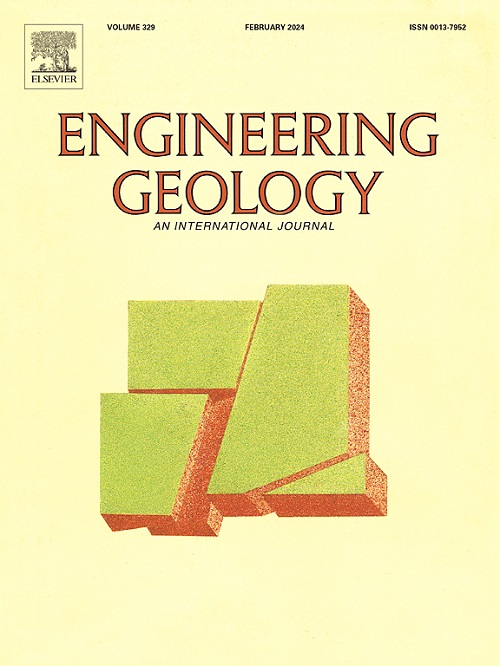Data-driven sparse learning of three-dimensional subsurface properties incorporating random field theory
IF 6.9
1区 工程技术
Q1 ENGINEERING, GEOLOGICAL
引用次数: 0
Abstract
Geotechnical engineers rely on accurate soil property information for engineering analyses. However, it is challenging for spatial learning of soil attributes because in-situ geotechnical testing is typically performed sparsely at discrete locations, and soil properties also exhibit inherent spatial variability. Traditional geostatistical methods for predicting spatial properties at these unsampled locations exhibit high computational complexity and require pre-determination of hyper-parameters, while pure data-driven methods fail to integrate geotechnical knowledge. In this study, a hybrid and parameter-free framework that uses random field theory and machine learning is proposed to model 3D subsurface field with reduced computational complexity. The framework constructs site-specific basis functions for characterizing the spatial variations of soil properties by decomposing a correlation matrix through principal component analysis. To further reduce the computational complexity involved in processing high-dimensional correlation matrices, a sparse sampling strategy is adopted to map correlation matrix onto lower-rank principal component space. A series of synthetic random field examples are generated to illustrate the impact of scale of fluctuation and autocorrelation functions on the accuracy and sensitivity of subsurface modeling. The performance of the proposed method is further validated using both synthetic cases and two real case histories. It is demonstrated that the proposed method generally achieves higher R2 and lower root mean square error (RMSE) and mean absolute percentage error (MAPE) compared to state-of-the-art methods, such as Kriging and Bayesian compressive sensing. Moreover, the proposed method facilitates the explicit quantification of uncertainty associated with the subsurface models, providing valuable insights for engineering design and analysis. The data and code used in this study are available at https://github.com/Data-Driven-RFT/Sparse-Learning.
结合随机场理论的三维地下性质数据驱动稀疏学习
岩土工程师依靠准确的土壤性质信息进行工程分析。然而,土壤属性的空间学习具有挑战性,因为原位岩土测试通常是在离散的位置进行的,并且土壤属性也表现出固有的空间变异性。传统的地质统计学方法用于预测这些未采样位置的空间属性,计算复杂度高,需要预先确定超参数,而纯数据驱动的方法无法整合地质技术知识。在这项研究中,提出了一个混合和无参数框架,利用随机场理论和机器学习来模拟三维地下场,降低了计算复杂度。该框架通过主成分分析分解相关矩阵,构建了表征土壤性质空间变化的特定位点基函数。为了进一步降低处理高维相关矩阵的计算复杂度,采用稀疏采样策略将相关矩阵映射到低秩主成分空间。通过一系列的综合随机场实例,说明了波动尺度和自相关函数对地下模拟精度和灵敏度的影响。利用合成案例和两个真实案例进一步验证了所提方法的性能。研究表明,与Kriging和Bayesian压缩感知等最新方法相比,所提出的方法通常具有更高的R2和更低的均方根误差(RMSE)和平均绝对百分比误差(MAPE)。此外,该方法有助于明确量化与地下模型相关的不确定性,为工程设计和分析提供有价值的见解。本研究中使用的数据和代码可在https://github.com/Data-Driven-RFT/Sparse-Learning上获得。
本文章由计算机程序翻译,如有差异,请以英文原文为准。
求助全文
约1分钟内获得全文
求助全文
来源期刊

Engineering Geology
地学-地球科学综合
CiteScore
13.70
自引率
12.20%
发文量
327
审稿时长
5.6 months
期刊介绍:
Engineering Geology, an international interdisciplinary journal, serves as a bridge between earth sciences and engineering, focusing on geological and geotechnical engineering. It welcomes studies with relevance to engineering, environmental concerns, and safety, catering to engineering geologists with backgrounds in geology or civil/mining engineering. Topics include applied geomorphology, structural geology, geophysics, geochemistry, environmental geology, hydrogeology, land use planning, natural hazards, remote sensing, soil and rock mechanics, and applied geotechnical engineering. The journal provides a platform for research at the intersection of geology and engineering disciplines.
 求助内容:
求助内容: 应助结果提醒方式:
应助结果提醒方式:


